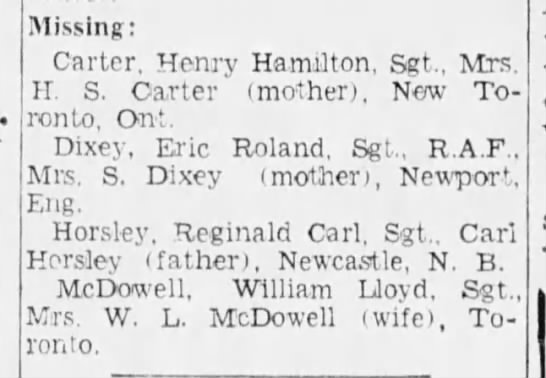
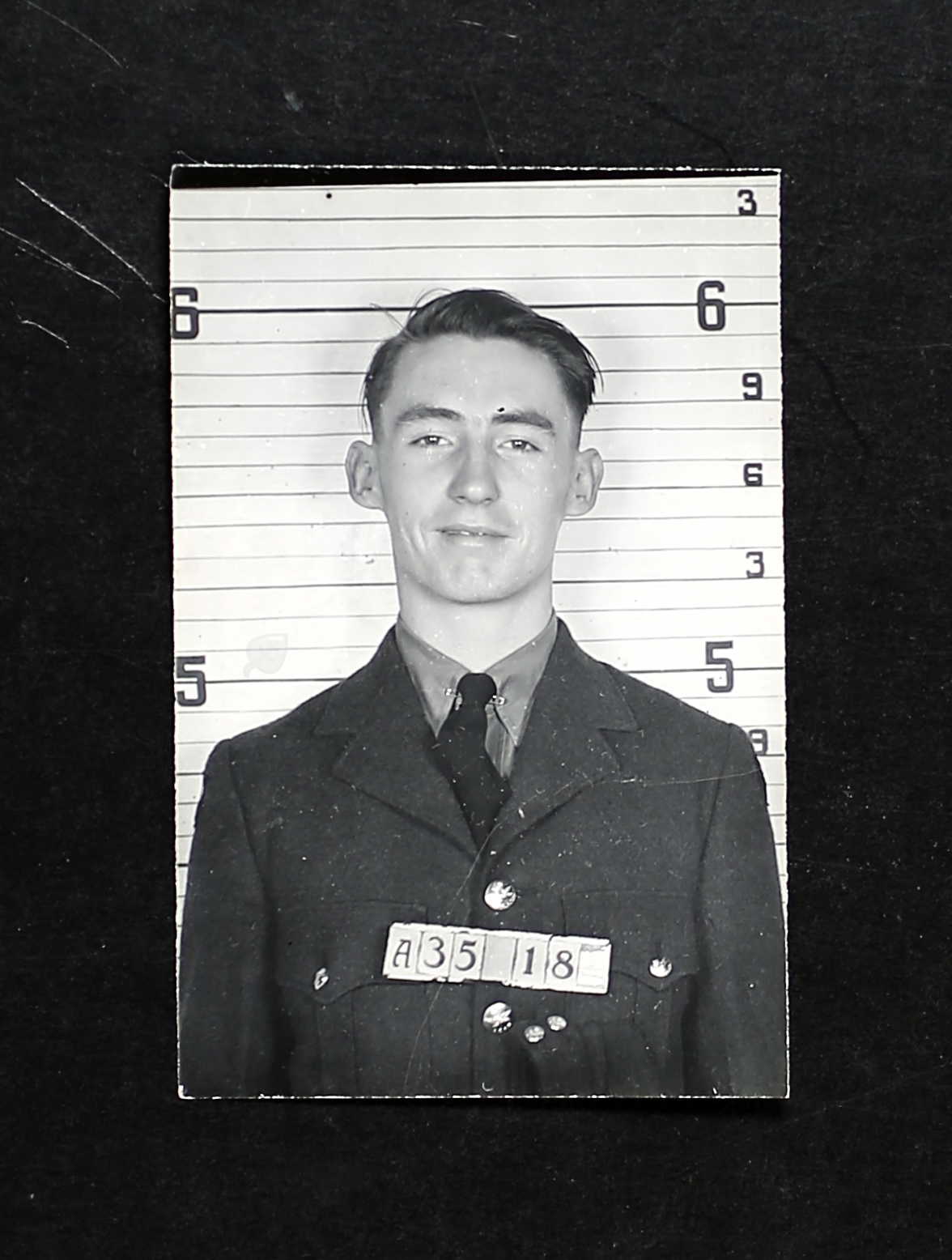
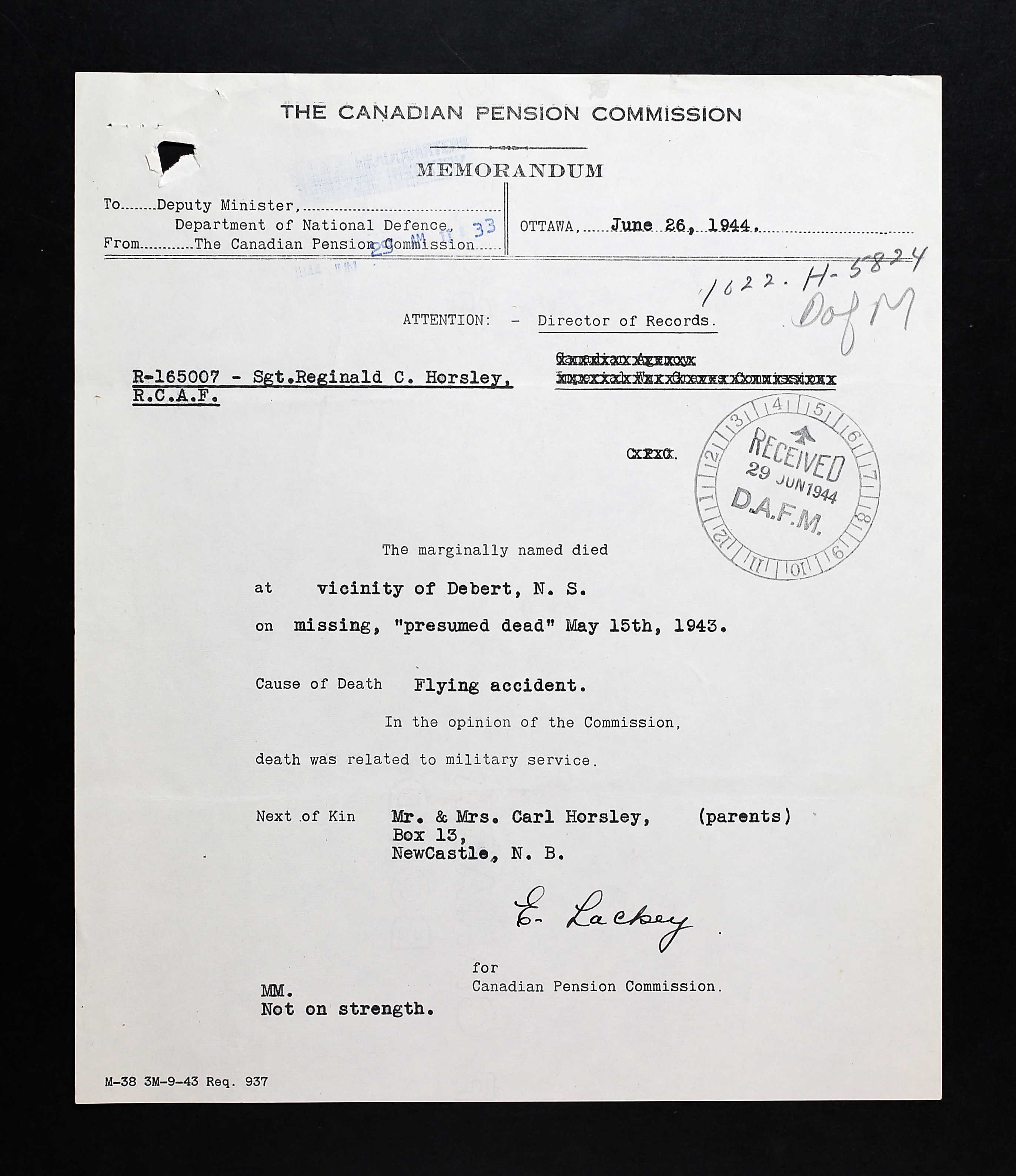
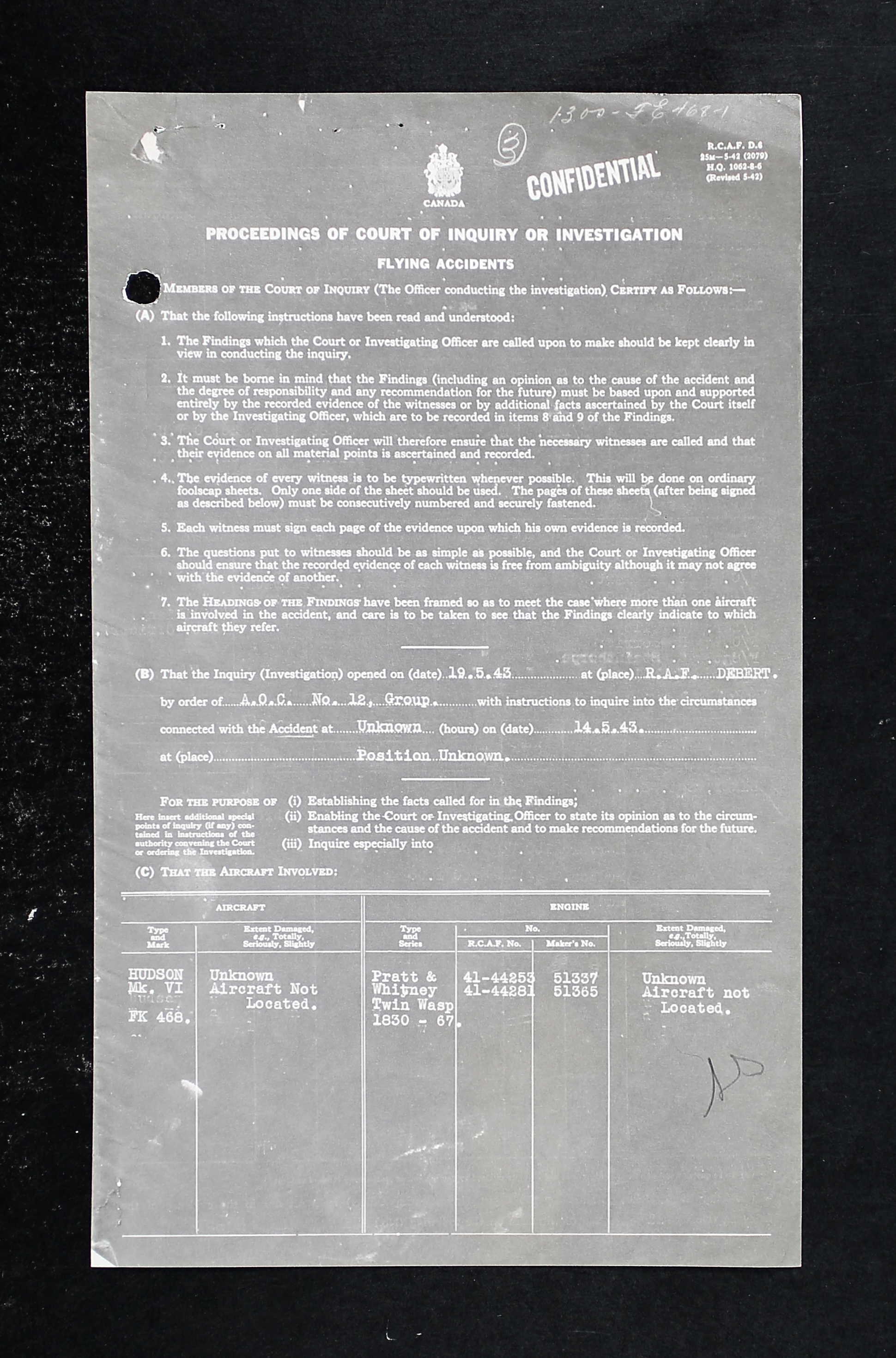
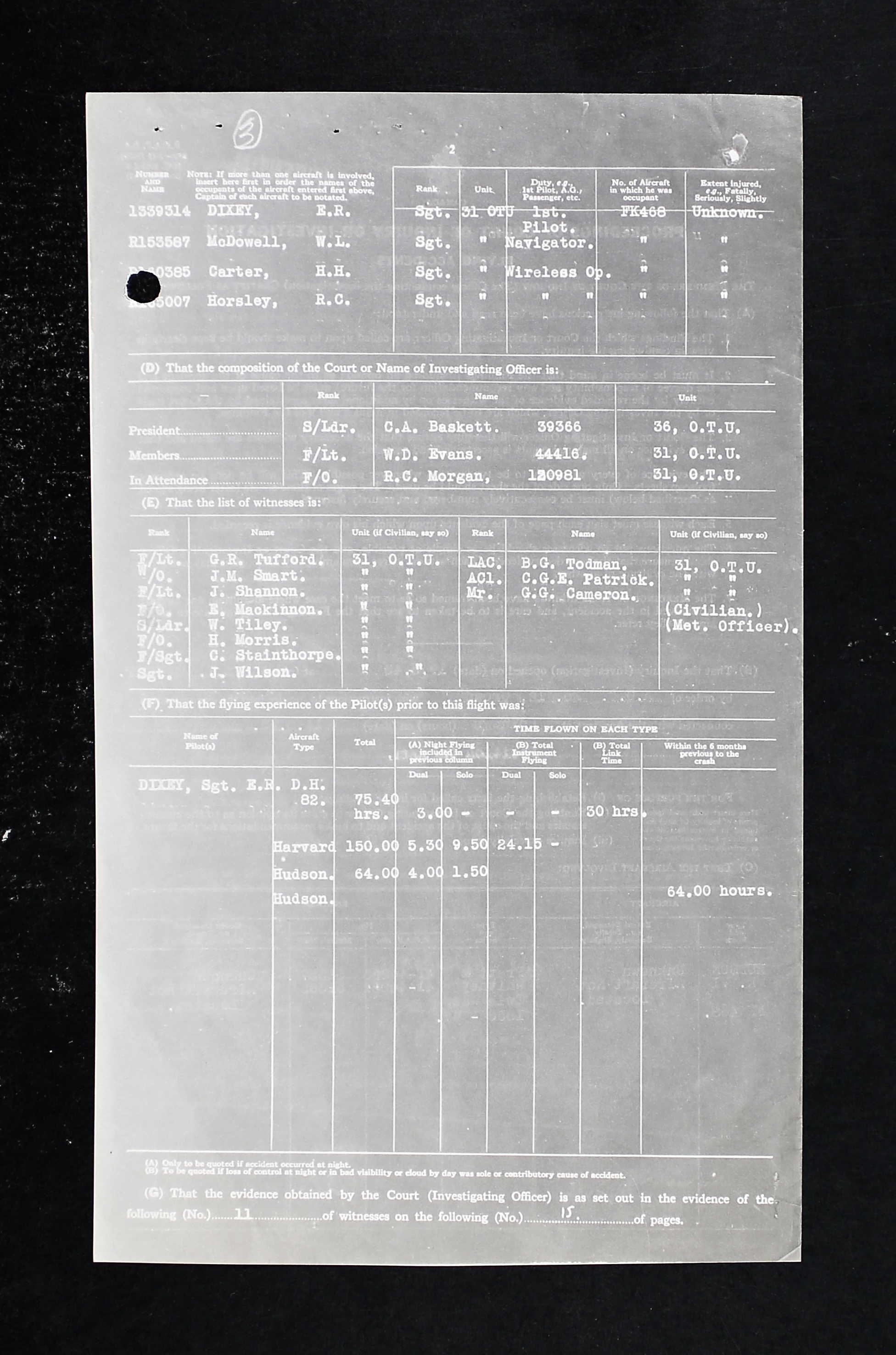
April 20, 1922 - May 15, 1943





Reginald Carl Horsley, born in Trenton, Ontario, was the son of Carl Horsley, agent for Canada Creosoting Co., and Edna Rosella (nee Malloy) Horsley of Newcastle, New Brunswick. He had four younger brothers: Douglas, Jan, Frederic, and Charles, and two sisters, Mrs. June Purcell, and Mrs. Betty Macintyre. They attended the United Church. Reg lived in Trenton for three years, then Truro, NS for two years, then in Newcastle, NB for 14 years.
He worked as a plumber’s helper in the fall of 1941, then worked as a helper of a radio tech until he enlisted with the RCAF in the spring of 1942. He took a correspondence course from the Radio College of Canada (Radio Technician) 1940-1941. Reg enjoyed swimming. He stood 1’ 11 ½” tall, had brown eyes and dark brown. hair. “Wiry. Standard mentality.” He weighed 129 pounds. He smoked ten cigarettes a day and drank alcohol occasionally/moderately. “Slightly underweight. Mild nasopharyngitis. Good all-round aircrew material.”
On his interview sheet: “Good type. Applied 7-4-42 as P&O and desired enrolment in pre-enlistment educational course, home in New Brunswick and on further consideration, finds he is financially unable to take course and desires WO (AG) completed about 1/3 of Radio College of Canada course in radio, could not continue because of finances, employed as service man in radio store November 1941 to March 1942, when applicant came to Toronto, considerable shooting having owned three rifles; cooperative, chief sport swimming; steady, impression courage, father born in Denmark. Mother Canadian. Good WOAG material. Recommended.”
Reg started his journey through the BCATP at No. 1 Manning Depot, Toronto on April 22, 1942 until he was sent to No. 4 Wireless School, Guelph on July 4, 1942. He forfeited pay in August 1942, AWL for two days. December 29, 1942, he was admonished and forfeited pay again for being AWL for one day. “78.3%. 36th out of 94 in class.”
From there, he was sent to Jarvis, Ontario and No. 1 B&G School until March 5, 1943. . He earned his Air Gunner’s Badge on February 22, 1943. “Average student. Somewhat retiring by nature. 11th out of 24 in class. Quiet and unassuming. Can be relied on.”
He was attached to No. 3 O.T.U. Debert, Nova Scotia March 5, 1943. In April 1943, he was at the station hospital for one day.
Hudson VI FK468, 31 O.T.U. on May 15, 1943, with crew members WOAG, Sgt. Henry Hamilton Carter, First Pilot, Sgt. Eric Rowland Dixey, 1339314, RAF, WOAG Sgt. Reginald Carl Horsley, R165006, and Navigator, Sgt. William Lloyd McDowell, R153587, RCAF went out on a night navigation exercise. The last message was received at 2245 hours on the second turning point -- both turning points were at sea. No further contact.
A full Court of Inquiry was held between May 19 and 20, 1943. (Microfiche C5937, image 3967). Eleven witnesses were called.
The first witness, F/L Charles Raymond Tufford, 41335, OC No. 2 Squadron, No. 31 O.T.U. stated, “Sgt Dixey and his crew commenced training in ‘C’ flight No. 2 Squadron on 3.5.43. Sgt. Dixey had completed 42 hours, 35 minutes in No. 1 Conversion Squadron on Hudson aircraft and approximately 18 ½ hours in my squadron before being reported missing. Of this time, 5 hours 50 minutes is dual and solo night flying circuits and landings. This crew had completed two day trips and was considered fit for a short navigation night exercise of 2-3 hours duration. On night of 14.5.43, he was detailed to carry out exercise Route 3 and took off at 2100 hours. I was informed at approximately 0830 hours 15.5.43 that the aircraft FK468 was missing and that a search had already been instigated. This crew’s progress in the squadron had been quite satisfactory. The dinghy and parachute drill is carried out by Ground Instruction school prior to entering No. 2 Squadron. The pilot was fully conversant with the cockpit drill and fuel system.”
The second witness, WO Joseph Maurice Smart, RAF stated that he was duty Instructor in No. 2 Squadron. “At approximately 30.40 I authorized Sgt Dixey as Captain of Aircraft No. FK468 to carry out Navigation Exercise No. 3 to take off at 2100 hours, with the following crew: McDowell, Carter, and Horsley. The aircraft took off at 2100 hours and was due to return at approximately 2359 but failed to return. I was asked by S/L Womersley at 0500 to organize three crews and three aircraft for a search for this aircraft to take off at 0630 hours on 15.5.43. I carried this out and sent off duty at about 0900 hours. I realize that this crew had completed their training up to the point where they were fit to do a short night cross country trip.”
The third witness, F/L John Edward Shannon, Controller Operations Room, stated that he “ascertained there were five aircraft to take off on a navigation exercise No, 3 starting at 2100 hours. Aircraft FK468 was given W/T go at 2135. This aircraft was ordered to send a position signal at each turning point and was due to arrive back by midnight. We received the first message sent from the first turning point at 22.24 hours. The message was received at 22.45 hours, i.e. three minutes after ETA at second turning point. No further contact was made with this aircraft. I was notified by Filter Room at EAC that an unknown aircraft had been plotted circling Musquadoboit Harbour and later proceeding down coast towards Halifax. This plotting however, was lost at approximately 10-15 miles up the coast from Halifax. At approximately 0045 hours on 15.5.43, I took all necessary overdue action and went off duty at 1030 hours.” He had no knowledge of the crew but he had heard that Sgt. Dixey was an above average pilot. The exercise was to be carried out at 3,000 feet.
The fourth witness, F/O Angus Gordon Mackinnon, J15282, Controller, stated that the trip would have taken normally about 2 ½ hours. “The crews were ordered to send out an OK message every half hour and a position message at every turning point. I knew nothing about this crew.”
The fifth witness, S/L William Godfrey Tiley, RAF, stated that “Sgt Carter carried out 13 hours 25 minutes on training exercises using Bendix Equipment. He was assessed as above average as an air operator and in ground subjects. Sgt. Horsley carried out 9 hours 20 minutes on training exercises on the Bendix and was assessed as average on ground and air exercises.” Both WOAG were fully conversant with all safety facilities to be used in the event of emergency.
The sixth witness, F/O Edward Morris, RAF stated that the navigational ability of Sgt. McDowell was that “he had completed two daylight navigational exercises previously, neither exercise had shown any apparent difficulties and assessments on both exercises had been average. Apart from this to the best of my knowledge, he was a keen pupil.” When asked if all navigators originate any coded messages, he replied, “Yes, but he was a little slow in learning.”
The next set of witnesses testified to the airworthiness of the aircraft and the weather, which was favourable.
The conclusions: “Aircraft missing on night navigation exercise. Cause of loss or position unknown. There has been no trace of the occupants and they must be presumed dead. Court of Inquiry might have made further inquiry of coastal ADC and patrol.”
In late October 1955, Mrs. Horsley received a letter informing her that since Reg had no known grave, his name would appear on the Ottawa Memorial.